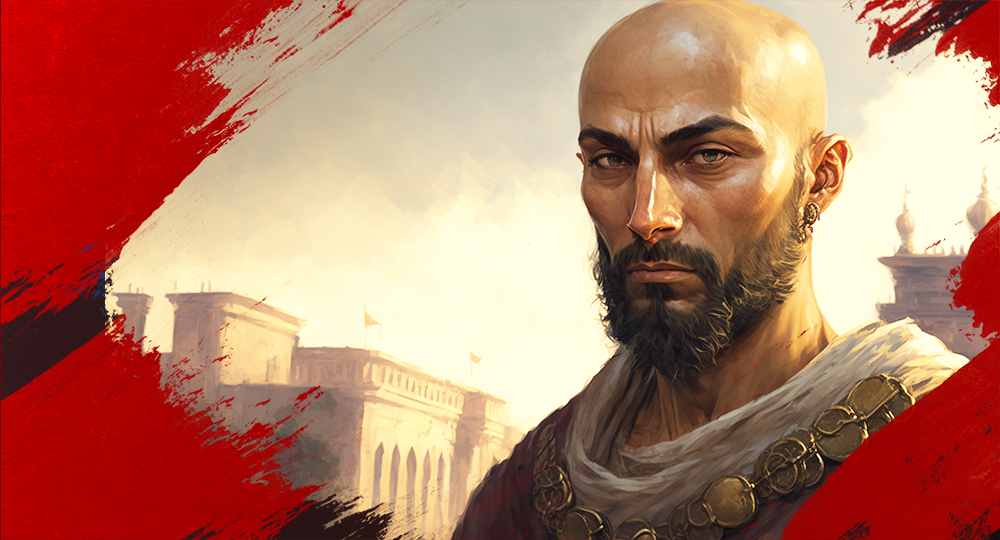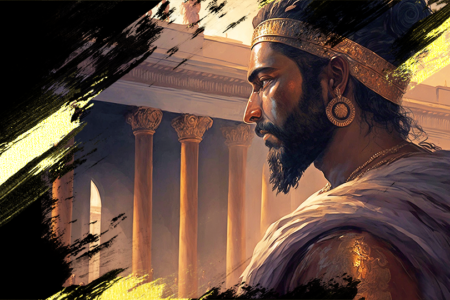Haman
He was the archetypal antisemite—and he came to a fitting end.
Villains! Where would literature, movies, or old-time radio serials be without them? From Sherlock Holmes’s Professor Moriarty to Peter Pan’s Captain Hook to Luke Skywalker’s Darth Vader, a good story requires a heavy—the antagonist who provides the drama.
Unfortunately, the Bible is filled with heavies, real-life villains who are pawns of Satan. But one in particular stands out. His name was Haman.
Haman’s Prominence
Haman appears in the book of Esther. A proud, egotistical, self-absorbed bureaucrat, Haman was determined to annihilate the entire Jewish race because one member of it refused to bow down to him.
He rose to prominence in Esther 3, when Persian King Ahasuerus (Xerxes) “promoted Haman, the son of Hammedatha the Agagite, and . . . set his seat above all the princes who were with him” (v. 1).
Because Scripture calls Haman an Agagite, Bible scholars have debated his lineage for years. What, if any, relationship was there between Haman and Agag, the king of the Amalekites whom Israel’s King Saul was commanded by God (1 Sam. 15:3) to destroy? Saul spared Agag, whom the prophet Samuel then killed (v. 33).
While it is remotely possible that Haman descended from Agag, Bible commentator John A. Martin believes otherwise:
It seems unlikely that a high-ranking Persian official would be related to a west Semite who lived 600 years earlier. Archeologists have uncovered an inscription which indicates that Agag was also the name of a province in the Persian Empire. This probably explains why Haman was called an Agagite.1
Once promoted, it became obvious that Haman loved the preeminence, prestige, power, and praise that accompanied his newly exalted position: “All the king’s servants who were within the king’s gate bowed and paid homage to Haman, for so the king had commanded concerning him” (Est. 3:2).
Pride leads to arrogance, hatred, and prejudice; and Haman was well-infected with pride. When Mordecai refused to bow, “Haman was filled with wrath” (v. 5). Disdaining “to lay hands on Mordecai alone, . . . Haman sought to destroy all the Jews who were throughout the whole kingdom of Ahasuerus—the people of Mordecai” (v. 6). It wasn’t enough for him to kill only Mordecai.
His ego would be satisfied only after he killed the entire Jewish nation.
So Haman hatched a plot worthy of a true villain and persuaded his king to go along with it. He told Ahasuerus,
There is a certain people scattered and dispersed among the people in all the provinces of your kingdom; their laws are different from all other people’s, and they do not keep the king’s laws. Therefore it is not fitting for the king to let them remain. If it pleases the king, let a decree be written that they be destroyed, and I will pay ten thousand talents of silver into the hands of those who do the work, to bring it into the king’s treasuries (vv. 8–9).
Since Haman also planned to “plunder their possessions” (v. 13), he probably intended to seize the Jewish assets for the kingdom and possibly add to it from his own wealth.
Whatever the case, the money he planned to put “into the king’s treasuries” was substantial. According to Greek scholar Frank Egleston Robbins, the Athenians in the late 4th century BC (100 years later) spent two talents to build an entire naval ship.2 Ten thousand talents would have built 5,000 ships. No wonder Ahasuerus went along with Haman, never even asking the identity of this “certain people.”
The Decree of Death
In Nisan, the first month of the Jewish ceremonial year (March/April), a decree was issued “and sealed with the king’s signet ring” (v. 12).
Letters were sent by couriers into all the king’s provinces to destroy, to kill, and to annihilate all the Jews, both young and old, little children and women, in one day, on the thirteenth day of the twelfth month . . . Adar [February/March], and to plunder their possessions (v. 13).
The decree gave the Jews a full year to mourn their tragic, unexpected fate. “In every province” (4:3), all 127 of them (1:1), Jews were mourning, “fasting, weeping, and wailing; and many lay in sackcloth and ashes” (4:3).
Upon learning what was happening from her cousin Mordecai, Queen Esther bravely entered the king’s presence unbidden. When Ahasuerus received her warmly, she invited him and Haman to a banquet, where she then invited them to a second banquet the following day.
These two invitations further stoked Haman’s ego, made him “joyful,” and gave him “a glad heart” until the moment he saw the unyielding Mordecai in the king’s gate (5:9).
Vexed to the core, Haman complained to his wife and friends, who suggested, “Let a gallows be made, fifty cubits high [75 feet], and in the morning suggest to the king that Mordecai be hanged on it; then go merrily with the king to the banquet” (v. 14). What an inspired solution to his problem! That way he wouldn’t have to wait an entire year to rid himself of Mordecai. He could do it right away. “So he had the gallows made” (v. 14).
Haman Humbled
But God had other plans. That night, unable to sleep, Ahasuerus had the annals read to him and learned about an assassination plot Mordecai had uncovered, saving the king’s life (6:1–2).
Anxious to reward Mordecai, the king asked, “Who is in the court?” In God’s providence, “Haman had just entered the outer court of the king’s palace to suggest that the king hang Mordecai” (v. 4). God’s timing is always perfect!
The king asked Haman, “What shall be done for the man whom the king delights to honor?” (v. 6). Thinking, “Whom would the king delight to honor more than me?” (v. 6), Haman made a suggestion that asked nothing for his wife, his 10 sons, or his friends. It was wholly self-centered and reminiscent of Satan’s declaration in Isaiah 14: “I will be like the Most High” (v. 14). Haman wanted to be like the king. So he told Ahasuerus,
Let a royal robe be brought which the king has worn, and a horse on which the king has ridden, which has a royal crest placed on its head. Then let this robe and horse be delivered to the hand of one of the king’s most noble princes, that he may array the man. . . . Then parade him on horseback through the city square, and proclaim before him: “Thus shall it be done to the man whom the king delights to honor!” (Est. 6:8–9).
Pleased, Ahasuerus replied, “Hurry, . . . and do so for Mordecai the Jew” (v. 10).
Oh, the humiliation Haman was forced to endure while a 75-foot-high gallows, the equivalent of a modern five- or six-story building, stood ready for Mordecai in Haman’s backyard.
That night, at the second banquet, Esther revealed the plot against her people. Enraged, Ahasuerus demanded, “Who is he, and where is he, who would dare presume in his heart to do such a thing?” (7:5).
Esther replied, “The adversary and enemy is this wicked Haman!” (v. 6). That, of course, was the end of Haman. Had he known Esther was Jewish, he may not have been so quick to go after the Jewish people. But God, in His wisdom, made sure Haman did not know. Esther had kept her ethnicity a secret.
Immediately, servants covered Haman’s face. When Harbonah, one of the eunuchs, said Haman had built gallows on which to hang Mordecai, Ahasuerus declared, “Hang him on it!” (v. 9).
Martin, in The Bible Knowledge Commentary, said the gallows “probably was an impaling stake, a common method of execution in the ancient world.”3 And it probably was tall enough for everyone in the city to see because Harbonah apparently pointed to it from the palace, saying, “Look! The gallows, fifty cubits high, which Haman made for Mordecai” (v. 9).
Although the decree to kill the Jews could not be revoked, Ahasuerus gave Mordecai the authority to countermand it by allowing the Jews to fight back. When they did, they killed all 10 of Haman’s sons (9:10). Thus ends the story of the villain Haman.
Pride is probably humanity’s biggest problem. It prevents people from seeing their need of a Savior and from accepting the truths contained in the Bible.
God hates pride (Prov. 8:13) and resists the proud (Jas. 4:6), who are wise in their own eyes and deceive themselves into trusting in their own self-worth, making it extremely difficult for them to humble themselves before a holy God. So, sadly, they miss the free gift of eternal life that God has provided for sinners who trust in Him.
ENDNOTES
-
- John A. Martin, “Esther,” The Bible Knowledge Commentary, ed. John F. Walvoord and Roy B. Zuck (Wheaton, IL: Victor Books, 1985), 705.
- Frank Egleston Robbins, “The Cost to Athens of Her Second Empire,” Classical Philology 13, no. 4 (Oct. 1918, University of Chicago Press), 366 (jstor.org/stable/262943).
- Martin, 708.









Is the spirit of Haman alive in the US today? It appears there are many in government desiring to end the Judeo Christian culture with jail, censorship, persecution, investigations, etc.